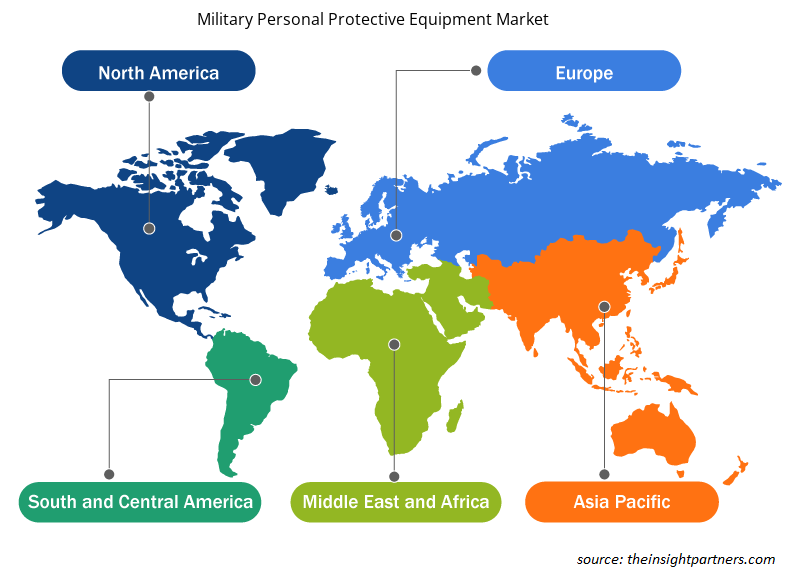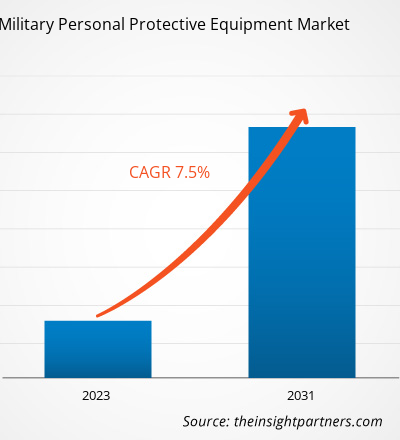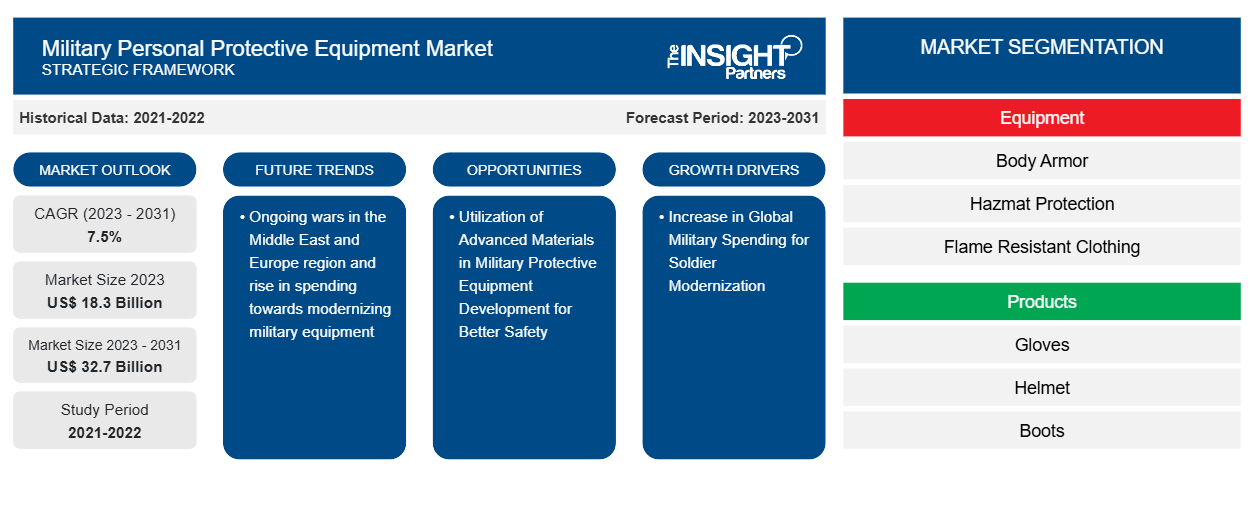Si prevede che la dimensione del mercato dei dispositivi di protezione individuale militari raggiungerà i 32,7 miliardi di dollari entro il 2031, rispetto ai 18,3 miliardi di dollari del 2023. Si prevede che il mercato registrerà un CAGR del 7,5% nel 2023-2031. Le guerre in corso nella regione del Medio Oriente e dell'Europa e l'aumento della spesa per la modernizzazione delle attrezzature militari e per garantire la sicurezza del personale militare sono tra i fattori chiave che guidano il mercato dei dispositivi di protezione individuale militari.
Analisi del mercato dei dispositivi di protezione individuale militari
La crescita dei dispositivi di protezione individuale militari in tutto il mondo è principalmente guidata dall'aumento dei budget per la difesa e dai crescenti sforzi di modernizzazione dei soldati militari. Inoltre, la crescente domanda di vari dispositivi militari sta aumentando poiché i governi di tutto il mondo si stanno concentrando sempre di più sulla modernizzazione dei soldati a causa delle crescenti preoccupazioni per la sicurezza. Si prevede che la complessità sostenuta e incerta dell'ambiente di sicurezza internazionale in tutto il mondo aumenterà la spesa per la difesa da parte delle autorità della regione nei prossimi cinque anni. Inoltre, le aziende in tutto il mondo sono fortemente coinvolte nella progettazione e nella fornitura di dispositivi di protezione individuale militari che a loro volta si prevede guideranno la crescita del mercato nei prossimi anni. Alcune delle aziende impegnate nella progettazione di dispositivi di protezione individuale militari sono Ceradyne (3M), Honeywell International, BAE Systems, DuPont e Ansell Ltd., tra le altre.
Panoramica del mercato dei dispositivi di protezione individuale militari
Nel recente passato, la domanda di dispositivi di protezione individuale militari è aumentata a causa della situazione di guerra in Afghanistan, Iraq, Libia e Serbia. Inoltre, la crescente produzione nucleare dell'Iran ha intensificato le tensioni militari tra Stati Uniti, Israele e Iran. La crescente domanda di dispositivi di protezione avanzati tra le diverse forze militari è un fattore importante che guida la crescita del mercato dei dispositivi di protezione individuale militari (DPI). I primi cinque spendaccioni militari nell'anno 2023 sono Stati Uniti, Cina, India, Arabia Saudita e Russia, che aumentano l'approvvigionamento di dispositivi di protezione individuale militari in questi paesi. Si prevede che la richiesta di dispositivi di protezione individuale militari sarà guidata dalle grandi iniziative di modernizzazione dei finanziatori della difesa negli Stati Uniti e dalle minacce alla sicurezza interna come il terrorismo organizzato e la criminalità. Inoltre, un aumento significativo delle tensioni transfrontaliere tra India, Cina e Pakistan sta guidando la crescita del mercato dei dispositivi di protezione individuale militari (DPI) nell'Asia Pacifica.
Personalizza questo report in base alle tue esigenze
Riceverai la personalizzazione gratuita di qualsiasi report, comprese parti di questo report, o analisi a livello nazionale, pacchetto dati Excel, oltre a usufruire di grandi offerte e sconti per start-up e università
- Scopri le principali tendenze di mercato in questo rapporto.Questo campione GRATUITO includerà analisi di dati che spaziano dalle tendenze di mercato alle stime e alle previsioni.
Driver e opportunità del mercato dei dispositivi di protezione individuale militari
Aumento della spesa militare globale per la modernizzazione dei soldati
Il combattimento moderno porta a diversi confronti di scenari complessi sul campo di battaglia; quindi, i soldati affrontano un'ampia varietà di minacce, come dispositivi esplosivi improvvisati (IED) e attacchi di granate a propulsione a razzo. Queste minacce consentono un aumento della domanda di diversi DPI, come caschi , occhiali per la visione notturna, giubbotti antiproiettile e indumenti, che forniscono una maggiore protezione e consapevolezza della situazione ai soldati. Inoltre, per soddisfare la domanda di modernizzazione dei soldati e sicurezza del personale militare, i governi e le associazioni in tutto il mondo stanno aumentando i finanziamenti e la spesa per infrastrutture ed equipaggiamenti militari. Secondo lo Stockholm International Peace Research Institute (SIPRI), nel 2023, la spesa militare globale totale valutata in 2.443 miliardi di dollari è aumentata da 2.240 miliardi di dollari nel 2022. Quindi, si prevede che l'aumento della spesa militare in tutto il mondo guiderà il mercato dei dispositivi di protezione individuale militari nei prossimi anni.
Utilizzo di materiali avanzati nello sviluppo di equipaggiamenti protettivi militari per una migliore sicurezza
Gli operatori del mercato, insieme al governo, sono impegnati in una costante ricerca e sviluppo (R&S) di nuovi design di DPI utilizzando materiali di qualità ottimale e innovativi per far fronte alla crescente domanda degli utenti finali. Inoltre, i produttori si stanno concentrando sullo sviluppo di nuove tecnologie come i materiali nanotecnologici nei giubbotti antiproiettile per offrire un'armatura flessibile e leggera, che sta beneficiando dell'espansione del mercato. Ad esempio, alcuni dei materiali avanzati offerti dalla società 3M per lo sviluppo di dispositivi di protezione individuale militari sono 3M Scotchlite Reflective Material 6755 Series e 3M Scotchlite Reflective Material 8710 Series, tra gli altri.
Il sistema 3M PELTOR Steel Mesh MultiVisor V4A-10P, 10 EA/scatola; 3M PETG Faceshield WE96S, 82580-00000, Flat Stock, Short, Clear, 50 EA/scatola; e il sistema visiera 3M PELTOR Brush Defender, V40AH9A-1P con paraorecchie H9A, 1 EA/scatola, tra gli altri, per lo sviluppo della maschera protettiva. L'applicazione di materiali avanzati e DPI efficaci richiede un equilibrio tra il completamento di una missione e il mantenimento del compito e la protezione fisiologica, psicologica e fisica dei soldati. L'integrazione di materiali e tecnologie avanzate comprende rivestimenti o materiali che hanno un'elevata permeabilità per aumentare il trasferimento di calore evaporativo dal corpo ed evitare la diffusione di sostanze chimiche tossiche sulla pelle. Pertanto, si prevede che l'uso di materiali avanzati nello sviluppo di dispositivi di protezione individuale militari creerà opportunità per i principali attori che operano nel mercato.
Analisi della segmentazione del rapporto di mercato sui dispositivi di protezione individuale militari
I segmenti chiave che hanno contribuito alla derivazione dell'analisi del mercato dei dispositivi di protezione individuale militari sono le attrezzature, i prodotti e l'utente finale.
- In base all'equipaggiamento, il mercato dei dispositivi di protezione individuale militari è stato suddiviso in giubbotti antiproiettile, protezione da materiali pericolosi, indumenti ignifughi, altro. Il segmento dei giubbotti antiproiettile ha detenuto una quota di mercato maggiore nel 2023.
- In base ai prodotti, il mercato dei dispositivi di protezione individuale militari è stato suddiviso in guanti, caschi, stivali, occhiali, maschere facciali, altro. Il segmento dei caschi ha detenuto una quota di mercato maggiore nel 2023.
- Sulla base dell'utente finale, il mercato è stato segmentato in forza terrestre, forza aerea, marina. Il segmento della forza terrestre ha dominato il mercato nel 2023.
Analisi della quota di mercato dei dispositivi di protezione individuale militari per area geografica
L'ambito geografico del rapporto sul mercato dei dispositivi di protezione individuale militari è suddiviso principalmente in cinque regioni: Nord America, Europa, Asia Pacifico, Medio Oriente e Africa e Sud America.
Il Nord America ha dominato il mercato dei dispositivi di protezione individuale militari nel 2023. La regione del Nord America comprende Stati Uniti, Canada e Messico. Stati Uniti e Canada sono tra i principali paesi nordamericani che investono ingenti somme nelle loro forze militari. I dipartimenti della difesa di questi paesi hanno costantemente adottato varie tecnologie avanzate per fornire tecnologie pronte per la missione ai soldati. La crescente spesa militare ha influenzato positivamente l'adozione di varie tecnologie moderne, come i dispositivi di protezione individuale militari. Inoltre, la domanda di vari equipaggiamenti militari è in aumento poiché i governi della regione nordamericana si stanno concentrando sempre di più sulla modernizzazione dei soldati a causa delle crescenti preoccupazioni per la sicurezza. Si prevede che la complessità sostenuta e incerta dell'ambiente di sicurezza internazionale in tutto il mondo aumenterà la spesa per la difesa da parte delle autorità della regione nei prossimi cinque anni. Inoltre, si prevede che la maggiore enfasi dell'amministrazione statunitense sul miglioramento della protezione e delle capacità del soldato sarà uno dei principali motori di crescita della spesa per la difesa nei prossimi anni.
Approfondimenti regionali sul mercato dei dispositivi di protezione individuale militari
Le tendenze regionali e i fattori che influenzano il mercato dei dispositivi di protezione individuale militari durante il periodo di previsione sono stati ampiamente spiegati dagli analisti di Insight Partners. Questa sezione discute anche i segmenti del mercato dei dispositivi di protezione individuale militari e la geografia in Nord America, Europa, Asia Pacifico, Medio Oriente e Africa e Sud e Centro America.

- Ottieni i dati regionali specifici per il mercato dei dispositivi di protezione individuale militari
Ambito del rapporto sul mercato dei dispositivi di protezione individuale militari
| Attributo del report | Dettagli |
|---|---|
| Dimensioni del mercato nel 2023 | 18,3 miliardi di dollari USA |
| Dimensioni del mercato entro il 2031 | 32,7 miliardi di dollari USA |
| CAGR globale (2023-2031) | 7,5% |
| Dati storici | 2021-2022 |
| Periodo di previsione | 2023-2031 |
| Segmenti coperti | Per equipaggiamento
|
| Regioni e Paesi coperti | America del Nord
|
| Leader di mercato e profili aziendali chiave |
|
Densità degli attori del mercato dei dispositivi di protezione individuale militari: comprendere il suo impatto sulle dinamiche aziendali
Il mercato dei dispositivi di protezione individuale militari sta crescendo rapidamente, spinto dalla crescente domanda degli utenti finali dovuta a fattori quali l'evoluzione delle preferenze dei consumatori, i progressi tecnologici e una maggiore consapevolezza dei vantaggi del prodotto. Con l'aumento della domanda, le aziende stanno ampliando le loro offerte, innovando per soddisfare le esigenze dei consumatori e capitalizzando sulle tendenze emergenti, il che alimenta ulteriormente la crescita del mercato.
La densità degli operatori di mercato si riferisce alla distribuzione di aziende o società che operano in un particolare mercato o settore. Indica quanti concorrenti (operatori di mercato) sono presenti in un dato spazio di mercato in relazione alle sue dimensioni o al valore di mercato totale.
Le principali aziende che operano nel mercato dei dispositivi di protezione individuale militari sono:
- Sistemi di protezione Avon Inc.
- MKU limitata
- Società di armature degli Stati Uniti
- DuPont de Nemours, Inc.
- Honeywell International Inc.
- Società a responsabilità limitata
Disclaimer : le aziende elencate sopra non sono classificate secondo un ordine particolare.

- Ottieni una panoramica dei principali attori del mercato dei dispositivi di protezione individuale militari
Notizie e sviluppi recenti sul mercato dei dispositivi di protezione individuale militari
Il mercato dei dispositivi di protezione individuale militari viene valutato raccogliendo dati qualitativi e quantitativi dopo la ricerca primaria e secondaria, che include importanti pubblicazioni aziendali, dati associativi e database. Di seguito è riportato un elenco degli sviluppi nel mercato dei dispositivi di protezione individuale militari e delle strategie:
- A settembre 2021, Leidos si è aggiudicata un contratto con la Defense Advanced Research Projects Agency (DARPA). Grazie a questo contratto, Leidos svilupperà una tecnologia per equipaggiamenti di protezione avanzati per l'esercito statunitense.
- A settembre 2021, SKYDEX ha stretto una partnership con ArmorSource. Questa partnership mirava a innovare la tecnologia dei caschi per proteggere le comunità militari e delle forze dell'ordine.
Copertura e risultati del rapporto sul mercato dei dispositivi di protezione individuale militari
Il rapporto "Dimensioni e previsioni del mercato dei dispositivi di protezione individuale militari (2021-2031)" fornisce un'analisi dettagliata del mercato che copre le seguenti aree:
- Dimensioni e previsioni del mercato a livello globale, regionale e nazionale per tutti i segmenti di mercato chiave coperti dall'ambito
- Dinamiche di mercato come fattori trainanti, vincoli e opportunità chiave
- Principali tendenze future
- Analisi dettagliata delle cinque forze di Porter
- Analisi di mercato globale e regionale che copre le principali tendenze di mercato, i principali attori, le normative e gli sviluppi recenti del mercato
- Analisi del panorama industriale e della concorrenza che copre la concentrazione del mercato, l'analisi della mappa di calore, i principali attori e gli sviluppi recenti
- Profili aziendali dettagliati con analisi SWOT
- Analisi storica (2 anni), anno base, previsione (7 anni) con CAGR
- Analisi PEST e SWOT
- Valore/volume delle dimensioni del mercato - Globale, Regionale, Nazionale
- Industria e panorama competitivo
- Set di dati Excel
Report recenti
Rapporti correlati
Testimonianze
Motivo dell'acquisto
- Processo decisionale informato
- Comprensione delle dinamiche di mercato
- Analisi competitiva
- Analisi dei clienti
- Previsioni di mercato
- Mitigazione del rischio
- Pianificazione strategica
- Giustificazione degli investimenti
- Identificazione dei mercati emergenti
- Miglioramento delle strategie di marketing
- Aumento dell'efficienza operativa
- Allineamento alle tendenze normative





















 Ottieni un campione gratuito per - Mercato dei dispositivi di protezione individuale militari
Ottieni un campione gratuito per - Mercato dei dispositivi di protezione individuale militari